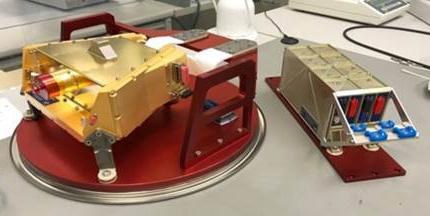DLR contributions to the CHEOPS mission



The Berlin-based DLR Institutes of Optical Sensor Systems and Planetary Research (now merged to form the DLR Institute of Space Research) are contributing two electronic modules to ESA's CHEOPS (CHaracterising ExOPlanet Satellite) mission, including the core component of the satellite – the Focal Plane Module. This module contains the CCD (charge-coupled device) detector and its electronics. The German Aerospace Center (Deutsches Zentrum für Luft- und Raumfahrt; DLR) is also involved in the scientific analysis of the data collected during the mission.
The challenge in designing and building the two electronic modules was to ensure their thermo-mechanical stability. Strict adherence to operating temperature and structural stability is crucial to the success of the CHEOPS mission, as it enables the highly accurate measurements required. Achieving sufficient thermo-mechanical stability meant breaking new technological ground during the development and construction of the modules. The tight timeline posed a further challenge, as both components had to be developed in a very short period, between 2013 and 2017. The Focal Plane Module (FPM) was delivered to the University of Bern for integration into the payload in November 2017; the Sensor Electronics Module (SEM) followed in May 2018.
Because CHEOPS is designed to detect extremely small variations in starlight, the thermal requirements for these components are extremely strict: the CCD detector and associated low-noise electronics must be kept at a constant operating temperature – fluctuations must not exceed 0.01 kelvin (10 millikelvin). Only if this requirement is met can the mission’s scientific goals be achieved – namely, measuring the brightness of stars with extreme precision and determining the radius of orbiting planets with the utmost accuracy.
The Focal Plane Module houses the CCD detector – the core component of CHEOPS onto which starlight is focused. On the sides of the module are the circuit boards with the readout electronics. The sensitivity of CHEOPS’ measurements depends on the thermal stability of the detector and its electronics. The Sensor Electronics Module contains additional electronics for controlling the sensor – such as a temperature controller, processor and software – and is installed slightly offset from the FPM.
A high-precision temperature control system combines a passive cooling element (radiator) and an active heater to ensure the thermo-mechanical stability of the Focal Plane Module. In addition, the structure of the FPM is made of a special beryllium alloy – characterised by its extremely low thermal expansion and low mass.
Neither the CoRoT satellite (2006–2014) nor the 26-camera PLATO satellite – currently being readied for launch in 2026 – included such a highly stable temperature control system, relying instead on light curves to subsequently calculate temperature fluctuations in their detectors.
Another technical first in the CHEOPS mission is the CCD detector's thermally insulating mount. For the first time in an ESA satellite, a component manufactured by 3D printing, via selective laser melting in a titanium alloy, has been used in a critical location. The structurally sophisticated design – the entire component is about the size of an egg – could not have been realised using conventional manufacturing methods.
